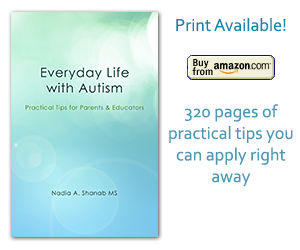Nadia Shanab | Uncategorized
A study at Yale School of medicine found that infants who paid less attention to people’s overtures and social activities may be diagnosed with autism later. The eye movements were tracked while watching a video of a woman doing everyday things, such as making a sandwich, looking at toys, or speaking. Children later diagnosed with
[read more]
Nadia Shanab | Uncategorized
A paper in the Pertanika Journal reports the positive effect of music therapy on behavior in children with autism, and in particular on the inattentive behavior. The paper reports that a weekly one-hour music therapy can have a positive effect on the behavior of children with autism. It was also mentioned that: “music and movement
[read more]
Comments Off on Music Therapy Improves Behavior in Children with Autism
Nadia Shanab | Uncategorized
Boys are 4 to 5 times likely to be diagnosed with autism than girls are. Why? Maybe because of their camouflaged symptoms? Or maybe because her biology (by nature) protects her from developing autism? Researchers always wondered. A new study lead by researchers at Harvard Medical School supports the idea of a “female protective effect“.
[read more]
Comments Off on Why Are Girls Less Likely to Be Autistic?
Nadia Shanab | Uncategorized
At Mitchigan State University, researchers have found that newborns with low-birth weight are seven times more likely to be diagnosed with autism later in childhood, if ultrasound right after birth showed enlarged ventricles (brain cavities holding spinal fluid). This finding may lead to early detection of autism. The early detection will allow early intervention before
[read more]
Nadia Shanab | Uncategorized
You may submit your questions to Temple Grandin durning the INTERACTIVE show on autism-live.com on Monday, March 4, 2013. Mark the date. Read more about the show here: autism-tips.com/?p=1668 nadia shanab
[read more]
2 Mar 2013 | Tags:
autism,
communication,
consequences,
discipline,
flexibility,
health,
independence,
occupational therapy,
organization,
parenting,
sensory,
social interaction,
speech,
Temple Grandin,
tips,
transition
Nadia Shanab | Uncategorized
Temple Grandin, the most famous and accomplished autistic adult of our time, will appear in the interactive show: autism-live.com on March 4 th. Please mark the date. To find more details about the show click here: news.yahoo.com/celebrated-author-temple-grandin-appear-autism-live-com-231631419.html Also read my article: autism-tips.com/?p=257 nadia shanab
[read more]
2 Mar 2013 | Tags:
autism,
communication,
discipline,
flexibility,
health,
independence,
organization,
parenting,
research,
rewards,
rules,
social interaction,
Temple Grandin,
tips,
transition,
visual aids Comments Off on Temple Grandin to Appear in A Show March 4
Nadia Shanab | Uncategorized
A simple way to define autism is to describe it as: a different brain wiring. We have been repeating this as a metaphore or an analogy to get a better understanding of the condition. Today a research in Boston Children’s Hospital has published an amazing finding by using EEG to track the electrical cross-talk of
[read more]
Nadia Shanab | Uncategorized
I wrote an article entitled: “Dogs Can Help Your Autistic Child “: autism-tips.com/?p=797 to emphasize the benefits of having a dog on the autistic behavior. A very recent research from Australia has shown an increased positive social behaviors in the presence of an animal. The research was run on kids aging between five and thirteen
[read more]
Nadia Shanab | Uncategorized
Autism, ADHD (Attention Deficit Hyperactivity Disorder), bipolar disorder, major depressive disorder and schizophrenia, have in common variations in two genes. The two genes are involved in the balance of calcium in brain cells. This finding opens up an important new approach to drug treatment for these conditions and diseases. It is believed that the calcium
[read more]
Comments Off on Autism Shares Genetic Features With Psychiatric Disorders
Nadia Shanab | Uncategorized
Anecdote A problem on a Math worksheet asks students to draw a rectangle with dimensions larger than the regular paper dimensions. The directions give the length and the width of 2 sides (20 inches by 15 inches). Studnets were asked to find the length of the other 2 sides. Which are understandablely the same as
[read more]
Comments Off on “Pretending” A Skill That Can Be Aquired

